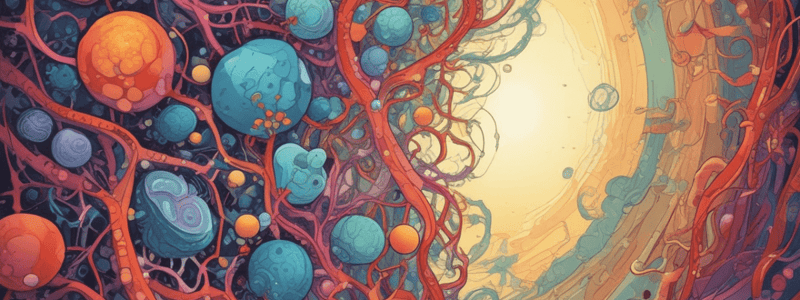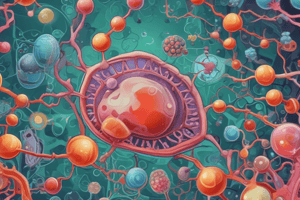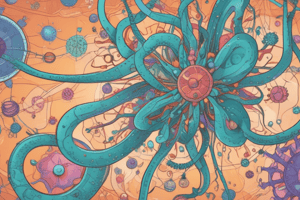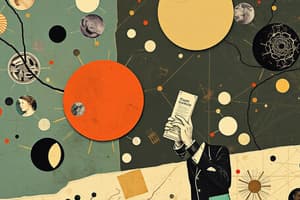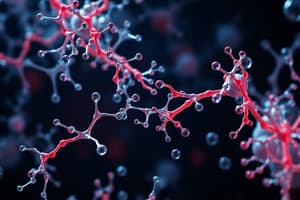Podcast
Questions and Answers
What is the main function of ribosomes in a cell?
What is the main function of ribosomes in a cell?
- Energy generation through cellular respiration
- Protein synthesis (correct)
- Digestion of cellular waste
- Protein modification and transport
Which biomolecule is composed of amino acid building blocks?
Which biomolecule is composed of amino acid building blocks?
- Proteins (correct)
- Lipids
- Nucleic acids
- Carbohydrates
What is the term for the breakdown of molecules in cellular processes?
What is the term for the breakdown of molecules in cellular processes?
- Photosynthesis
- Metabolism
- Catabolism (correct)
- Anabolism
Which type of cell lacks a nucleus?
Which type of cell lacks a nucleus?
What is the process by which cells make their own food from sunlight?
What is the process by which cells make their own food from sunlight?
What is the term for the 'building blocks of life'?
What is the term for the 'building blocks of life'?
Which organelle is responsible for generating energy for the cell through cellular respiration?
Which organelle is responsible for generating energy for the cell through cellular respiration?
What is the term for the process by which an organism's genetic information is passed from one generation to the next?
What is the term for the process by which an organism's genetic information is passed from one generation to the next?
Flashcards are hidden until you start studying
Study Notes
Cells
- Basic structural and functional units of life
- Consist of:
- Cell membrane (plasma membrane)
- Cytoplasm
- Genetic material (DNA or RNA)
- Cell types:
- Prokaryotic cells (no nucleus)
- Eukaryotic cells (nucleus present)
Cellular Organelles
- Mitochondria: generate energy for the cell through cellular respiration
- Endoplasmic reticulum (ER): involved in protein synthesis and transport
- Ribosomes: site of protein synthesis
- Lysosomes: contain digestive enzymes for breaking down cellular waste
- Golgi apparatus: involved in protein modification and transport
Biomolecules
- Carbohydrates:
- Monosaccharides (e.g. glucose)
- Polysaccharides (e.g. starch, cellulose)
- Proteins:
- Amino acid building blocks
- Primary, secondary, tertiary, and quaternary structures
- Lipids:
- Fats and oils
- Phospholipids (component of cell membranes)
- Nucleic acids:
- DNA (deoxyribonucleic acid)
- RNA (ribonucleic acid)
Cellular Processes
- Metabolism:
- Catabolism (breakdown of molecules)
- Anabolism (synthesis of molecules)
- Photosynthesis:
- Light-dependent reactions
- Light-independent reactions (Calvin cycle)
- Cellular respiration:
- Aerobic respiration (oxygen present)
- Anaerobic respiration (oxygen absent)
Genetics
- Mendelian genetics:
- Laws of inheritance (segregation, independent assortment, dominance)
- Punnett squares
- DNA replication:
- Semi-conservative model
- Leading and lagging strands
- Gene expression:
- Transcription (DNA to RNA)
- Translation (RNA to protein)
Evolution
- Mechanisms of evolution:
- Natural selection
- Genetic drift
- Mutation
- Gene flow
- Types of evolution:
- Microevolution (within a population)
- Macroevolution (between species)
- Evidence for evolution:
- Fossil record
- Comparative anatomy
- Molecular biology
Cells
- Cells are the basic structural and functional units of life
- Cell membrane (plasma membrane) regulates what enters and leaves the cell
- Cytoplasm is a jelly-like substance inside the cell membrane where metabolic processes occur
- Genetic material (DNA or RNA) contains instructions for cell growth and function
- Prokaryotic cells lack a nucleus, while eukaryotic cells have a nucleus that stores genetic material
Cellular Organelles
- Mitochondria are the site of cellular respiration, generating energy for the cell
- Endoplasmic reticulum (ER) is involved in protein synthesis, transport, and storage
- Ribosomes are responsible for protein synthesis, reading mRNA sequences
- Lysosomes break down cellular waste and foreign substances using digestive enzymes
- Golgi apparatus modifies and transports proteins and lipids
Biomolecules
- Monosaccharides (e.g. glucose) are simple sugars, the building blocks of carbohydrates
- Polysaccharides (e.g. starch, cellulose) are complex carbohydrates formed by monosaccharide bonds
- Amino acids are the building blocks of proteins, which have primary, secondary, tertiary, and quaternary structures
- Fats and oils are types of lipids, with phospholipids being a key component of cell membranes
- DNA (deoxyribonucleic acid) and RNA (ribonucleic acid) are nucleic acids that store genetic information
Cellular Processes
- Metabolism involves catabolism (breakdown of molecules) and anabolism (synthesis of molecules)
- Photosynthesis occurs in two stages: light-dependent reactions and light-independent reactions (Calvin cycle)
- Cellular respiration can occur aerobically (with oxygen) or anaerobically (without oxygen)
Genetics
- Mendelian genetics explains how traits are inherited, following laws of segregation, independent assortment, and dominance
- Punnett squares predict the probability of certain traits being passed down
- DNA replication occurs semi-conservatively, with leading and lagging strands
- Gene expression involves transcription (DNA to RNA) and translation (RNA to protein)
Evolution
- Mechanisms of evolution include natural selection, genetic drift, mutation, and gene flow
- Microevolution occurs within a population, while macroevolution occurs between species
- Evidence for evolution is found in the fossil record, comparative anatomy, and molecular biology
Studying That Suits You
Use AI to generate personalized quizzes and flashcards to suit your learning preferences.
